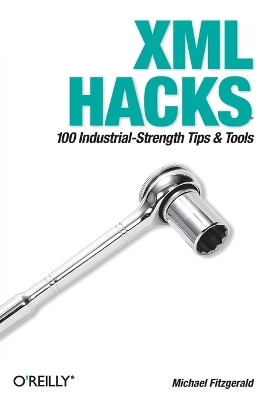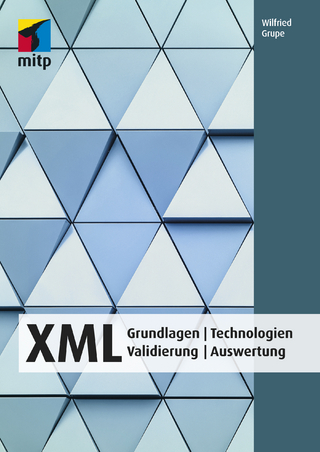
XML Hacks
O'Reilly Media (Verlag)
978-0-596-00711-9 (ISBN)
Developers and system administrators alike are uncovering the true power of XML, the Extensible Markup Language that enables data to be sent over the Internet from one computer platform to another or one application to another and retain its original format. Flexible enough to be customized for applications as diverse as web sites, electronic data interchange, voice mail systems, wireless devices, web services, and more, XML is quickly becoming ubiquitous. XML Hacks is a roll-up-your-sleeves guide that distills years of ingenious XML hacking into a complete set of practical tips, tricks, and tools for the web developers, system administrators, and programmers who want to go far beyond basic tutorials to leverage the untapped power of XML. With plenty of useful real-world projects that illustrate how to define, read, create, and manipulate XML documents, XML Hacks shows readers how to put XML's power to work on the Internet and within productivity applications. Each Hack in this book can be read easily in a few minutes, saving programmers and administrators countless hours of searching for the right answer.
And this is an O'Reilly Hacks book, so it's not just practical, imminently useful, and time-saving. It's also fun. From Anatomy of an XML Document to Exploring SOAP Messages XML Hacks shows you how to save time and accomplish more with fewer resources. If you want much more than the average XML user--to explore and experiment, do things you didn't know you could do with XML, discover clever shortcuts, and show off just a little--this invaluable book is a must-have.
Michael Fitzgerald is principal of Wy'east Communications, an XML consultancy. He is the author of Learning XSLT, published by O'Reilly in 2003, and of XML Hacks, forthcoming from O'Reilly in 2004. He is also the author of Building B2B Applications with XML and XSL Essentials, both published by John Wiley & Sons.
Credits Preface Chapter 1. Looking at XML Documents 1. Read an XML Document 2. Display an XML Document in a Web Browser 3. Apply Style to an XML Document with CSS 4. Use Character and Entity References 5. Examine XML Documents in Text Editors 6. Explore XML Documents in Graphical Editors 7. Choose Tools for Creating an XML Vocabulary 8. Test XML Documents Online 9. Test XML Documents from the Command Line 10. Run Java Programs that Process XML; Chapter 2. Creating XML Documents 11. Edit XML Documents with 12. Edit XML Documents with Emacs and nXML 13. Edit XML with Vim 14. Edit XML Documents with Microsoft Word 2003; 15. Work with XML in Microsoft Excel 2003 16. Work with XML in Microsoft Access 2003 17. Convert Microsoft Office Files, Old or New, to XML 18. Create an XML Document from a Text File with xmlspy 19. Convert Text to XML with Uphill 20. Create Well-Formed XML with Minimal Manual Tagging Using an SGML Parser 21. Create an XML Document from a CSV File 22. Convert an HTML Document to XHTML with HTML Tidy 23. Transform Documents with XQuery 24. Execute an XQuery with Saxon 25. Include Text and Documents with Entities 26. Include External Documents with XInclude 27. Encode XML Documents 28. Explore XLink and XML; 29. What's the Diff? Diff XML Documents 30. Look at XML Documents Through the Lens of the XML Information Set Chapter 3. Transforming XML Documents 31. Understand the Anatomy of an XSLT Stylesheet 32. Transform an XML Document with a Command-Line Processor 33. Transform an XML Document Within a Graphical Editor; 34. Analyze Nodes with TreeViewer 35. Explore a Document Tree with the xmllint Shell 36. View Documents as Tables Using Generic CSS or XSLT 37. Generate an XSLT Identity Stylesheet with Relaxer; 38. Pretty-Print XML Using a Generic Identity Stylesheet and Xalan; 39. Create a Text File from an XML Document 40. Convert Attributes to Elements and Elements to Attributes 41. Convert XML to CSV 42. Create and Process SpreadsheetML 43. Choose Your Output Format in XSLT 44. Transform Your iTunes Library File; 45. Generate Multiple Output Documents with XSLT 2.0 46. Generate XML from MySQL 47. Generate PDF Documents from XML and CSS; 48. Process XML Documents with XSL-FO and FOP 49. Process HTML with XSLT Using TagSoup 50. Build Results with Literal Result and Instruction Elements 51. Write Push and Pull Stylesheets; 52. Perform Math with XSLT 53. Transform XML Documents with grep and sed 54. Generate SVG with XSLT 55. Dither Scatterplots with XSLT and SVG 56. Use Lookup Tables with XSLT to Translate FIPS Codes 57. Grouping in XSLT 1.0 and 2.0 58. Use EXSLT Extensions; Chapter 4. XML Vocabularies 59. Use XML Namespaces in an XML Vocabulary 60. Create an RDDL Document 61. Create and Validate an XHTML 1.0 Document 62. Create Books, Technical Manuals, and Papers in XML with DocBook 63. Create a SOAP 1.2 Document; 64. Identify Yourself with FOAF 65. Unravel the OpenOffice File Format 66. Render Graphics with SVG 67. Use XForms in Your XML Documents Chapter 5. Defining XML Vocabularies with Schema Languages 68. Validate an XML Document with a DTD 69. Validate an XML Document with XML Schema 70. Validate Multiple Documents Against an XML Schema at Once 71. Check the Integrity of a W3C Schema 72. Validate an XML Document with RELAX NG 73. Create a DTD from an Instance 74. Create an XML Schema Document from an Instance or DTD 75. Create a RELAX NG Schema from an Instance; 76. Convert a RELAX NG Schema to XML Schema 77. Use RELAX NG and Schematron Together to Validate Business Rules 78. Use RELAX NG to Generate DTD Customizations 79. Generate Instances Based on Schemas; Chapter 6. RSS and Atom 80. Subscribe to RSS Feeds; 81. Create an RSS 0.91 Document 82. Create an RSS 1.0 Document; 83. Create an RSS 2.0 Document 84. Create an Atom Document; 85. Validate RSS and Atom Documents 86. Create RSS with XML::RSS; 87. Syndicate Content with Movable Type 88. Post RSS Headlines on Your Site 89. Create RSS 0.91 Feeds from Google 90. Syndicate a List of Books from Amazon with RSS and ASP Chapter 7. Advanced XML Hacks 91. Pipeline XML with Ant 92. Use Elements Instead of Entities to Avoid the "amp Explosion Problem" 93. Use Cocoon to Create a Well-Formed View of a Web Page, Then Scrape It for Data; 94. From Wiki to XML, Through SGML 95. Create Well-Formed XML with JavaScript 96. Inspect and Edit XML Documents with the Document Object Model 97. Processing XML with SAX 98. Process XML with C 99. Generate Code from XML 100. Create Well-Formed XML with Genx Index
| Erscheint lt. Verlag | 31.8.2004 |
|---|---|
| Reihe/Serie | Hacks |
| Verlagsort | Sebastopol |
| Sprache | englisch |
| Einbandart | kartoniert |
| Themenwelt | Informatik ► Programmiersprachen / -werkzeuge ► XML |
| Mathematik / Informatik ► Informatik ► Web / Internet | |
| ISBN-10 | 0-596-00711-6 / 0596007116 |
| ISBN-13 | 978-0-596-00711-9 / 9780596007119 |
| Zustand | Neuware |
| Haben Sie eine Frage zum Produkt? |
aus dem Bereich
